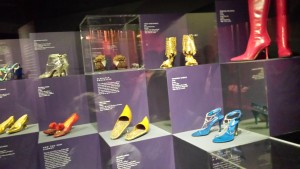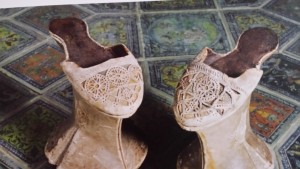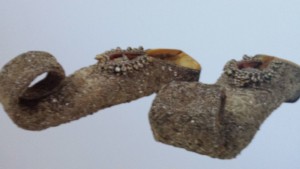.. is the exhibition at the Victoria & Albert Museum which I visited earlier this week. It’s a popular exhibition and, to avoid disappointment, I strongly advise anyone who plans to attend to get a  timed entrance ticket. It is worth a visit. In the V & A’s two storey self-contained ‘pod’ exhibition space, ‘Shoes’ displays footwear from across the globe and through-out the ages.
timed entrance ticket. It is worth a visit. In the V & A’s two storey self-contained ‘pod’ exhibition space, ‘Shoes’ displays footwear from across the globe and through-out the ages.
Is it a social history of, or through, footwear? No, it isn’t structured that way, preferring instead to highlight specific ways in which shoes (and other footwear) were indicative of wider society, like social hierarchies or sex and seduction. There is also a section on the making of shoes, either by hand or industrial process, but with the emphasis on the former. In addition there are two examples of shoe ‘collections’, belonging to Katie and Valeria ( no surnames are given but I assume, from the descriptions, that these are real people ) and a pair of sparkly stilettos belonging to Imelda Marcos – most infamous shoe collector of our time. This is an exhibition about admiring beautiful and beautifully made objects and the obsession which can sometimes go with that, though it’s also informative along the way.
The exhibition begins with the mythical, transformative dimension of shoes – the seven-league boots, the glass slipper and the red dancing shoes of fairy or folk tale ( the red shoes originally featured in a folk story, worn by Karen, not a ballet dancing Moira Shearer ). There is a neat juxtaposition made with modern football boots, which, their manufacturers claim, will transform the wearer and his or her skills, just as much as the seven-league boots transformed the lives of their wearers.
There is some interesting history of footwear. So, why shoes became heeled – thank you, Asiatic horse-riding peoples ( see A Day at the Races ) or became raised –  the chopine/chapin of French/Spanish aristocrats. There are wonderful examples of footwear from Persia and India and exhibits which defy belief from China. Was seven and a half centimetres – yes, centimetres – really the recommended length for a high-born Chinese lady’s foot? How much pain and deformation was required, from childhood, to enable a full-grown woman to wear what look like exquisite baby shoes?
the chopine/chapin of French/Spanish aristocrats. There are wonderful examples of footwear from Persia and India and exhibits which defy belief from China. Was seven and a half centimetres – yes, centimetres – really the recommended length for a high-born Chinese lady’s foot? How much pain and deformation was required, from childhood, to enable a full-grown woman to wear what look like exquisite baby shoes?
My personal favourites (and this exhibition rather demands that folk have their favourites) tended to be European shoes of the 1920s, for both men and women, or wonderful Arabian Nights style inlaid slippers.
There are broadcast interviews with Manolo Blahnik, Christian Louboutin and others and many references to celebrities, Sarah Jessica Parker, or her TV persona Carrie Bradshaw, Lady Gaga et al. And it is this aspect of the exhibition, it’s focus on celebrity, which is the least appealing aspect for me. I understand that shoes, and the industry which produces them, are about high fashion, but they’re about a lot more besides and somehow I found the fashion element pushing its strappy stiletto’ed way too much to the fore. But then this is in the Fashion area of the V & A, so perhaps it was my expectations at fault.
My other gripe is about the lack of a free leaflet or booklet. There are the big print spiral-bound booklets for the short-sighted ( like me ) but no ordinary leaflet outlining the exhibition and giving a curator’s view. There is, however, a strategically placed shop immediately outside the exhibition selling exhibition catalogues at £20 a time and postcards at £1 each ( photography is not allowed in the exhibition, though lots of people were taking photographs ). For a show which exploits the luxury and sheer cost of high-end footwear, this was, I thought, a bit cheap. At £12, the tickets aren’t the most expensive in London at the moment, but they aren’t the lowest priced either.
leaflet outlining the exhibition and giving a curator’s view. There is, however, a strategically placed shop immediately outside the exhibition selling exhibition catalogues at £20 a time and postcards at £1 each ( photography is not allowed in the exhibition, though lots of people were taking photographs ). For a show which exploits the luxury and sheer cost of high-end footwear, this was, I thought, a bit cheap. At £12, the tickets aren’t the most expensive in London at the moment, but they aren’t the lowest priced either.
I enjoyed my visit to the exhibition, gripes aside and, as was clear at the time, lots of other people did too. There was more general conversation about the exhibits than I have heard at many another exhibition, which must be a good thing. The predominant gender of visitors was female, though there were some men ( less than 10% I’d say ). Also, when I was there, there was a goodly number of sketching fashion/art students of both genders.
One other word of advice to anyone attending – check your coat at the cloakroom before going into the exhibition. It’s very popular and very warm! The exhibition runs until 31st January 2016.
If you enjoyed reading this article you might also enjoy Fashion on the Ration Visit to Hertford House


 RSS – Posts
RSS – Posts